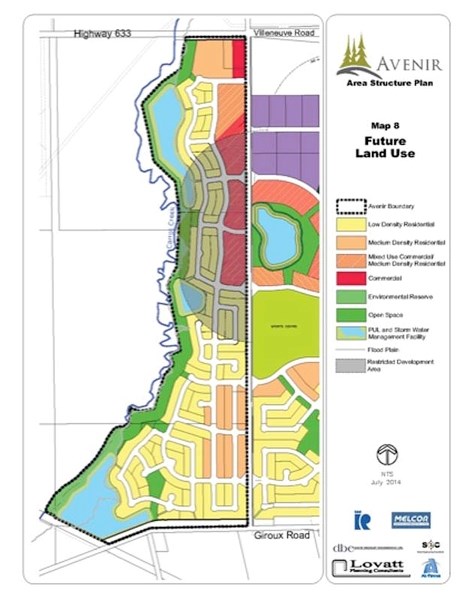The city's first high-tech neighbourhood is finally ready to go – at least on paper.
After five long years and numerous discussions with city councillors, the area structure plan for Avenir was given a go-ahead at Monday night's city council meeting.
Councillors voted 6-1 in favour of the plan, following a brief discussion which heard both applause and concern from several council members.
"We are getting close to a full build-out to the community and I think it's really critical that we make sure these neighbourhoods are built in a way that's sustainable," said Coun. Tim Osborne, who voted against approval of the ASP.
New area structure plan
Avenir, located between North Ridge and Carrot Creek south of Villeneuve Road, was first pitched as a blend of residential, commercial and industrial development.
The 85-hectare concept is to incorporate cutting-edge data technology to make the area suitable for companies and individuals in the technology business, particularly those serving the oilsands.
Since Avenir first approached the city in 2009, it has continuously struggled with red tape, including numerous changes to its area structure plan and a requirement to reclaim a landfill before moving ahead with its development.
The company returned before city council in mid-September to propose a new area structure plan.
At the time, council voted on two readings of the plan but a third reading was delayed to give councillors more time to consider the proposal.
The new plan said most of the Avenir lands will be developed as a residential community, including a mix of single-family and semi-detached homes as well as townhouses.
The total number of units proposed for the residential development is 1,730 of which 1,192 would be medium-to high-density units. About 20 per cent of the area is designated for commercial use.
Completion of the project is expected to take 10 to 15 years, pending servicing capacities and market demand.
Council comments
On Monday, Coun. Osborne expressed concerns over Avenir's dependency on the Elysian Fields, especially in supplying a school site for the more than 800 students expected to live in the Avenir neighbourhood.
Avenir was originally asked to jointly submit its application with neighbouring developer SAS Sports and Entertainment Group, the company behind St. Albert Sports City (Elysian Fields).
The SAS lands are expected to feature a major sports village along with a mixed use transit-oriented commercial area, and a residential node. Both developers share infrastructure.
The ASP for the Elysian Fields is expected to come before city council in the coming months.
"There are a number of design and financial assumptions that are built into this ASP where essentially you could say things will be balanced out by the Elysian Fields," said Osborne.
"I hope that's the case and I am glad that their ASP is coming forward. But as far as making this decision we are being asked to make a bit of a leap of faith."
Coun. Sheena Hughes voted in favour of the ASP but raised concerns over the higher housing density proposed by the development.
She expects the growth in population will increase staffing and policing costs in the city.
"I am disappointed that we have to keep seeing such high densities," she said.
Both Mayor Nolan Crouse and Coun. Gilles Prefontaine spoke in favour of higher densities.
Crouse said as the region is growing and more people are moving here, new residents require different housing options (other than single family homes.)
Neighbourhoods such as Avenir provide those options, he said.
"What we are seeing in some of these developments are changes and that is driven by the market," said Prefontaine.
"And that is driven by the fact that both baby boomers and millennials are looking for enhanced park space and they are looking for different types of housing."




